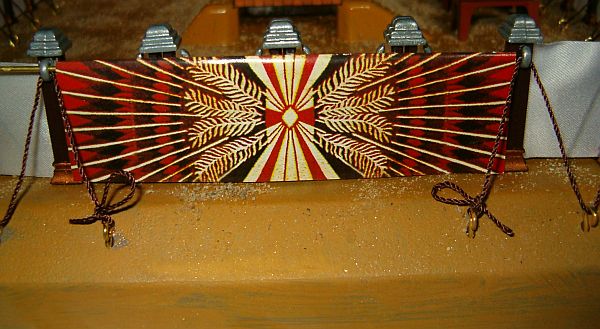 Exodus 26:36–37, Door of the tent. As with every other part of the tabernacle, the door is rich is rich in symbolic and prophetic significance pointing to Yeshua the Messiah and relating to the glorious message of the gospel in its full ramifying panoply.
Exodus 26:36–37, Door of the tent. As with every other part of the tabernacle, the door is rich is rich in symbolic and prophetic significance pointing to Yeshua the Messiah and relating to the glorious message of the gospel in its full ramifying panoply.
This door had the same colors as the door to the outer courtyard (blue, crimson, white and purple) and was also woven of fine linen. The door was the same size in area, though it was a different dimension than the first door, for it was taller and narrower. This teaches us that the view of Yeshua becomes higher, and the way to the holiest place becomes narrower and the requirements become more stringent as one draws closer in proximity to YHVH’s glorious presence.
Five wooden pillars covered in gold supported by bronze bases held the curtains up. Again, the wood-covered gold speaks of the righteousness of the saints. Bronze speaks of Elohim’s judgment and five can speak of both the five books of YHVH’s Torah as well as the five-fold ministry the purpose of which is to ground YHVH’s people in his Torah-instructions in righteousness. In so doing, the Saints will become like Yeshua, who was the physical embodiment of the Torah—or YHVH’s Torah-Word made flesh (the Living Torah, John 1:1, 14).
The Door of the Tent in More Detail
This door had the same coloring as the outer door: purple, white, crimson and blue. This door had different dimensions as the outer door, but occupied the same area. This door was about half the width, but twice as high as the outer door. This speaks of the fact that as one grows and matures spiritually, the way of life, the path of righteousness and the way to intimacy with the Father gets narrower and the standards are elevated.
It was held up by five pillars picturing the fivefold ministry (Eph 4:11), which is likened to a hand: The apostle is like the thumb. The other fingers cannot work properly without it. It has more flexibility than the rest and can do things the others can’t. The prophet is like the index finger and points out people’s faults and points the direction people are to walk in, yet he must be very gracious, humble and self-effacing in his activity since he has three fingers pointing back at himself. The evangelist represents the middle finger which extends or reaches outward the farthest to bring people to YHVH. The shepherd (pastor) is the ring finger representing gentleness and love. The teacher, like the little finger that is used to dig stuff out of one’s nose and ears, digs out nuggets of truth in hard to reach places (e.g. ear and nose).
The five pillars were made of acacia wood overlaid in gold, which speaks of Yeshua’s humanity and his divinity. The pillars were set in bases of bronze speaking of YHVH’s righteous judgments and that all judgment will be left up to Yeshua who is over all and has judged and will judge all (Heb 2:8; Eph 1:22). Furthermore, Yeshua as head of the body of believers, the gates of hell will not prevail against his elect (Matt 16:18; Heb 3:6).

